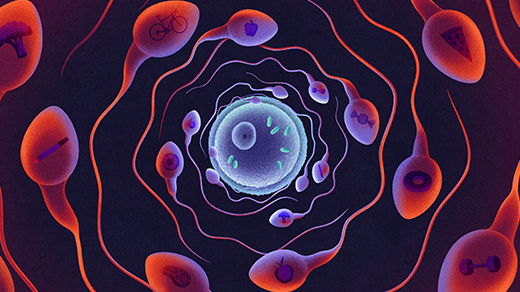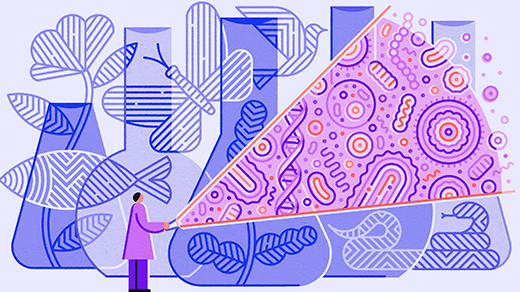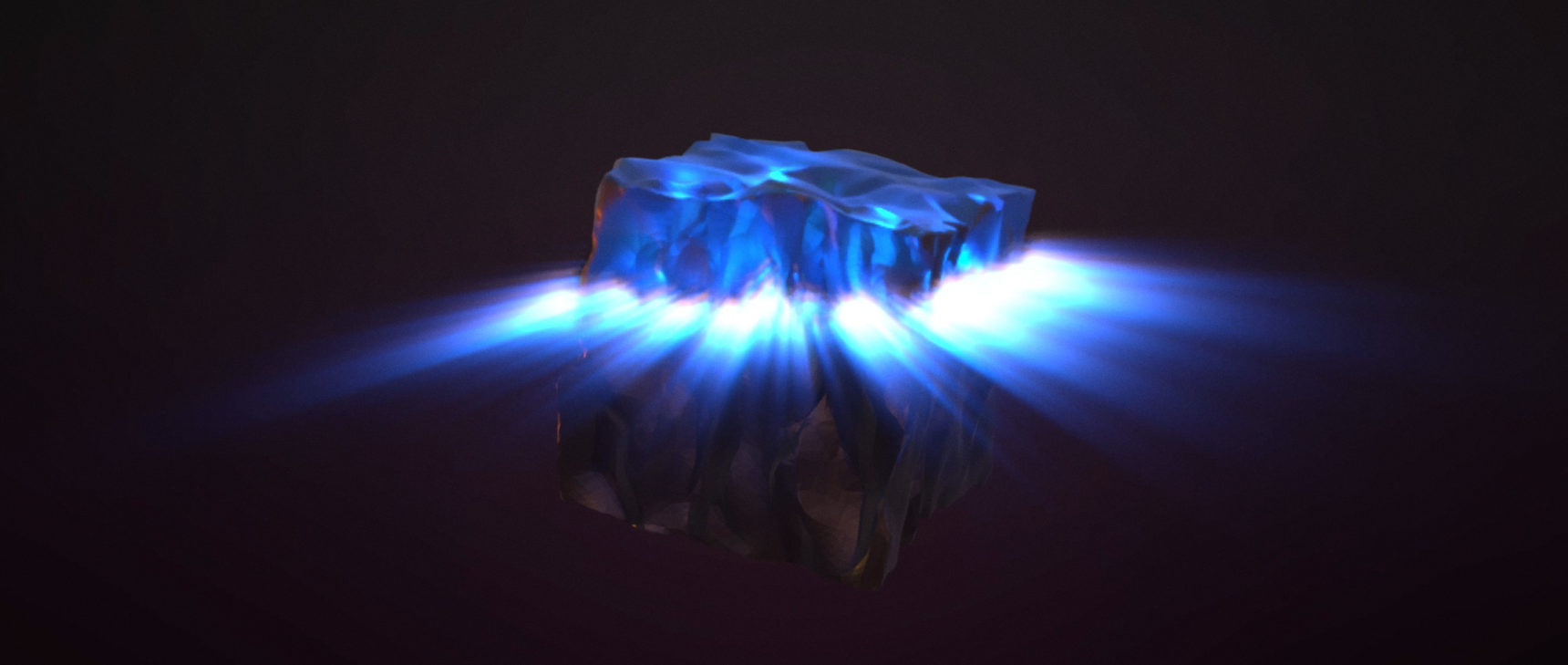Should Evolution Treat Our Microbes as Part of Us?
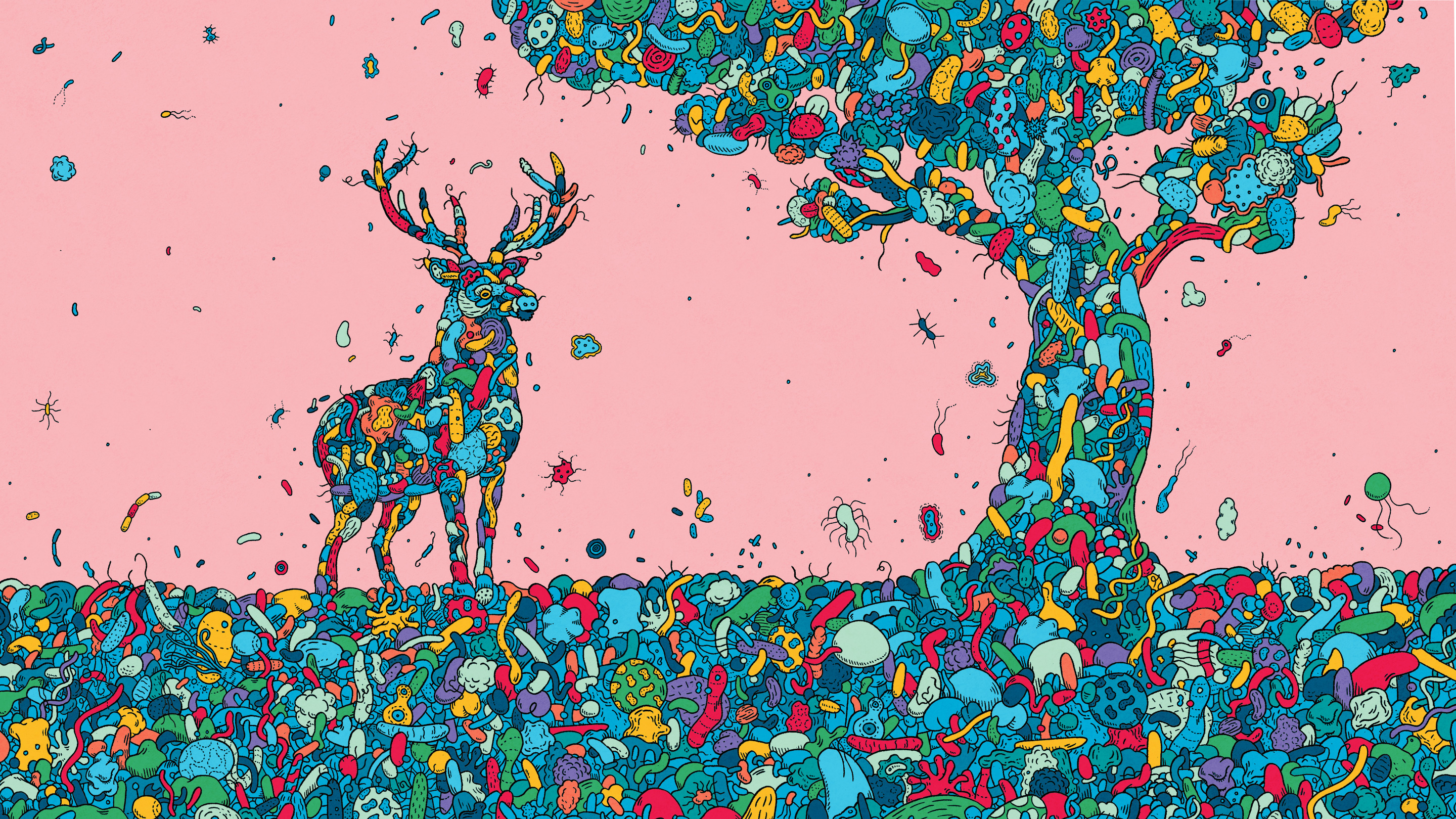
Microbiome science has revealed the deep interdependencies of animals and plants on their microbial partners, prompting calls for an expansion of evolutionary theory.
Andrew Rae for Quanta Magazine
Introduction
Twilight falls on the Tanzanian plain. As the sky turns a deeper purple, a solitary spotted hyena awakens. She trots along the border of her clan’s territory, marking the boundary with a sour paste from under her tail. She sniffs a passing breeze for hints of itinerant males interested in mating, giving little attention to her stomach’s rumbling over the remnants of the previous night’s hunt or the itch on her flank. The lone hyena chooses what she will do next to make her living.
Except she is not alone. That paste she secretes is produced not by her own cells but by billions of bacteria housed within her scent glands. The scents on the breeze from potential mates also come from unique microbial concoctions. A diverse array of bacteria that line her gut are helping to break down her meal. Others assist her immune system in fending off the hordes of parasites and pathogens trying to invade her skin and other tissues.
Who precisely is it, then, trying to survive on the Tanzanian plain? Can we consider the fates of the hyena and the microbes within her independently? Or does their interaction form something new, greater than each part alone?
“We’ve underestimated the potential contribution of microbes to traits we’ve been studying for decades or centuries,” said Kevin Theis, a microbiologist at Wayne State University who studies the paste-making microbes of the hyena. “If the genes for these important traits are actually in the microbiome and not the animal itself, then we need to take a systems-level approach and look at the host-microbe system as a whole.”
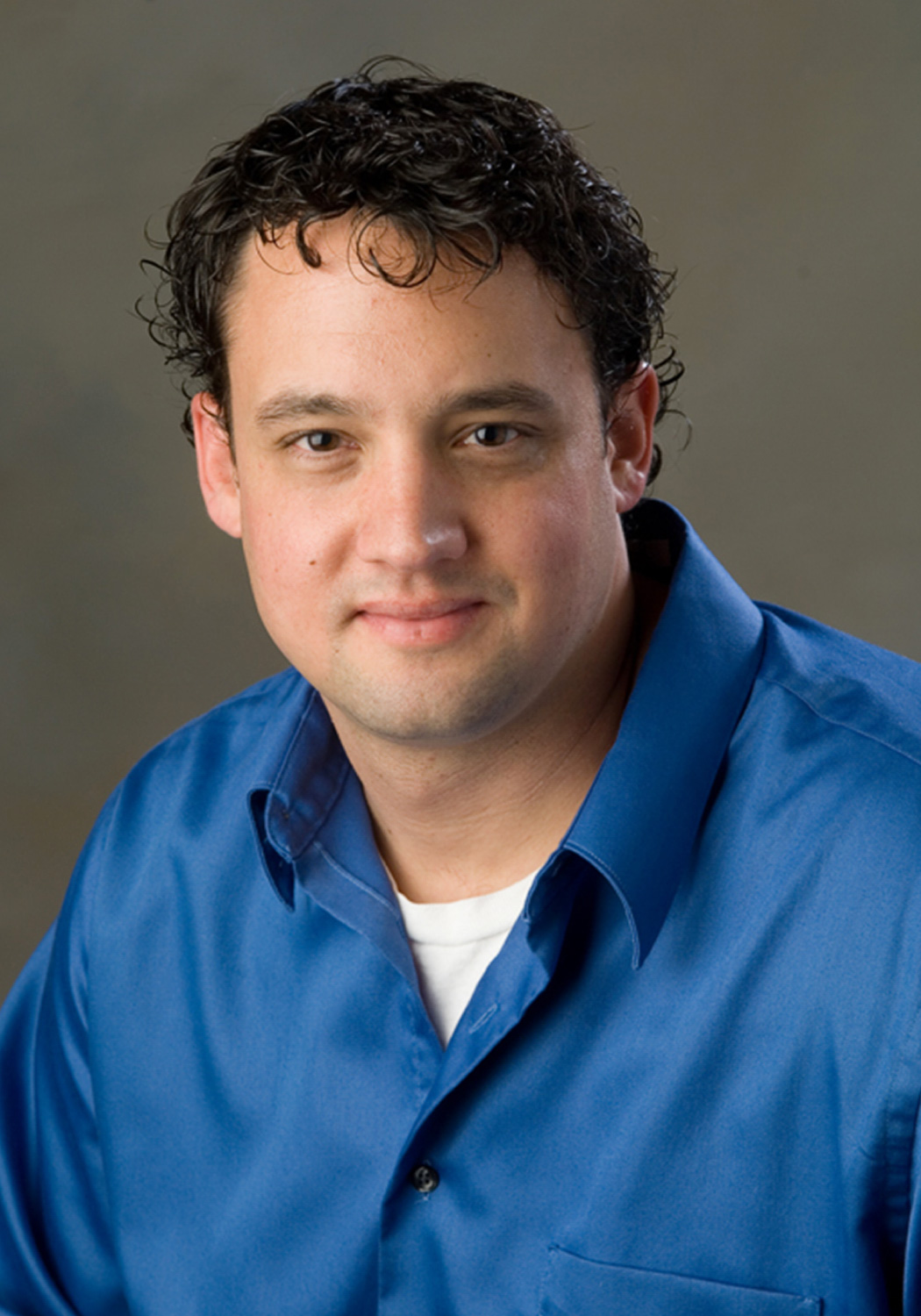
Kevin Theis, a microbiologist at Wayne State University, believes that evolutionary science needs to look at host-microbe systems as a whole.
Courtesy of Kevin Theis
Look closely enough at any plant or animal and you will discover a riot of bacteria, fungi and viruses forming a complex and interconnected ecosystem. A recent explosion of research reveals how deeply we rely on our microbial patterns to keep our bodies functioning, raising profound questions about what it means to be an individual.
Vital functions like digestion and immunity were long assumed to be under the purview of individual organisms, as capabilities developed and were refined through evolution by natural selection — the differential survival and reproduction of individuals. But if our bodies are less an autocracy of identical cells and more a coalition of multitudes, how can we explain their evolution?
Some biologists are calling for a radical upgrade of evolutionary theory, arguing that prevailing ideas, developed from the study of bigger, more easily understood organisms, don’t fit nicely into this new world. Others contend that existing theory just needs to be applied more carefully. All agree that the micro and macro worlds are inescapably interdependent, and that biologists must explore the frontier of their interconnections.
Never Alone
“We have never been individuals,” proclaimed a 2012 paper in The Quarterly Review of Biology by Scott Gilbert, a developmental biologist at Swarthmore College, and his colleagues. This bold assertion echoed previous calls for a reconceptualization of complex organisms as new kinds of individuals — holobionts. The term holobiont encompasses a host animal or plant and all its constituent microbes. All genes within a holobiont, belonging to host or microbes, constitute the “hologenome.”
Holobionts and hologenomes are “incontrovertible realities of nature,” wrote Theis and his colleagues in the journal mSystems. Hologenomes contain vastly more genes than the host genome alone, and since at least a fraction of the microbial genes have significant bearing on the survival and reproduction of the host, we need to consider the hologenome as a possible unit of selection if we want to understand the evolution of the holobiont.
“First and foremost, I think of the holobiont and hologenome as structural definitions,” said Seth Bordenstein, an evolutionary biologist at Vanderbilt University. Along with other researchers, Bordenstein argues that fresh language is needed to refer to this entity, given the ubiquity of host-associated microbes in nature. “We accept the chromosome or the genome as structures. The next level up is the hologenome,” he said.
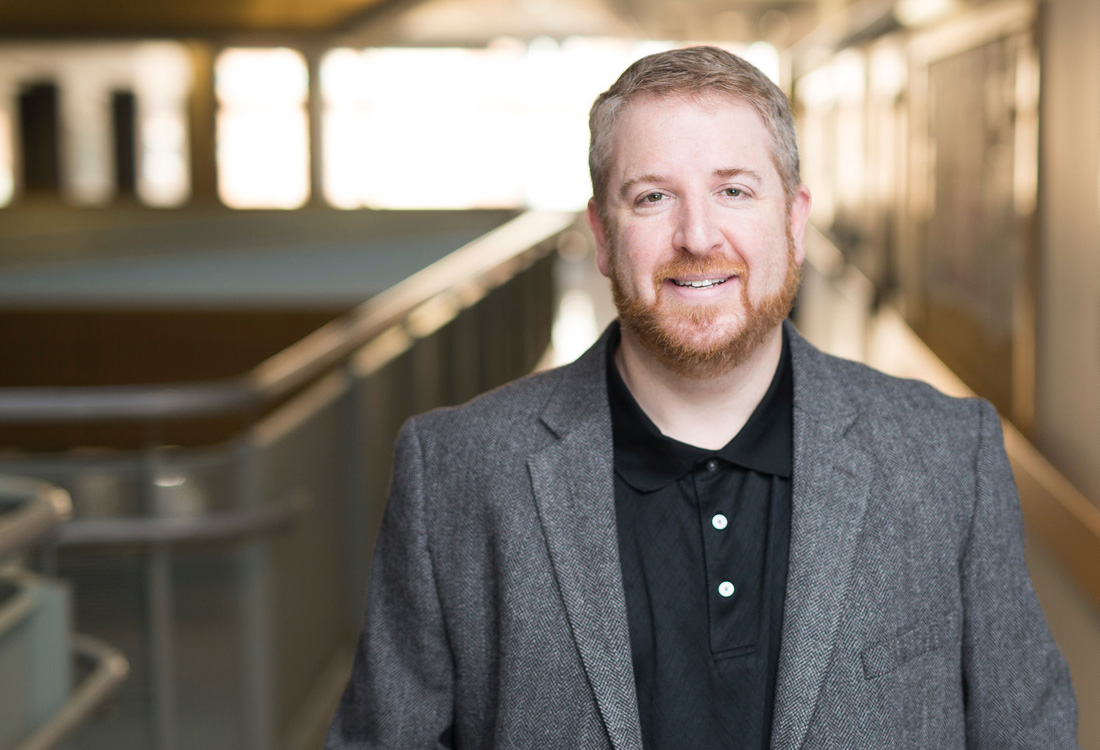
Seth Bordenstein, an evolutionary biologist at Vanderbilt University, argues that the ubiquity of host-associated microbes in nature suggests that “holobionts” need to be recognized as meaningful units.
Courtesy of Seth Bordenstein/Vanderbilt University
“The secondary question is: Does the hologenome matter?” he continued. No one knows what proportion of the microbiome will influence host fitness; many are surely just along for the ride. But if there is some degree of cooperation — for instance, if the host provides shelter or nutrients for some microbes that in return metabolize products the host can’t make on its own — then they are more than just two organisms occupying the same space. They are, to a degree, functionally integrated. And that raises the question of whether the hologenome might also matter evolutionarily.
The tighter the integration, the more closely intertwined the fates of host and microbe become. For such holobionts, Bordenstein says, you can’t understand the evolution of either the host genome or the microbial genomes in isolation because the community of organisms as a whole shapes the traits of the individual. “We need to understand what the microbes make, what the host makes and potentially how those products work together,” he said. The holobiont, he argues, adds up to more than the sum of the host and microbes. Out of their interaction emerges a coherent entity that natural selection might act on alongside other units of selection, like the individual or a gene.
Proponents of this hologenomic concept of evolution argue that if there is a fidelity across generations between hosts and microbes, then the holobiont embodies a coming together of numerous, disparate evolutionary lineages into a singular being, a coalition of many that contributes to the functional integrity of the whole. Only when considering the holobiont as a single entity capable of being shaped as a unit by natural selection can we make sense of its complexities.
Variation and Heritability
What might it mean for a holobiont to evolve through natural selection? How can traits emerging from the holobiont as a whole rather than from any individual line of cells in it be “chosen” by nature and spread in the population? The classic recipe for evolution by natural selection begins with a population of individuals with varying characteristics that affect the number of viable offspring they are likely to have. Those characteristics must be inheritable — that is, passed on with some fidelity from generation to generation. A trait could hypothetically double some lucky individual’s lifespan and number of offspring, but unless that trait gets passed on, it’s an evolutionary dead end.
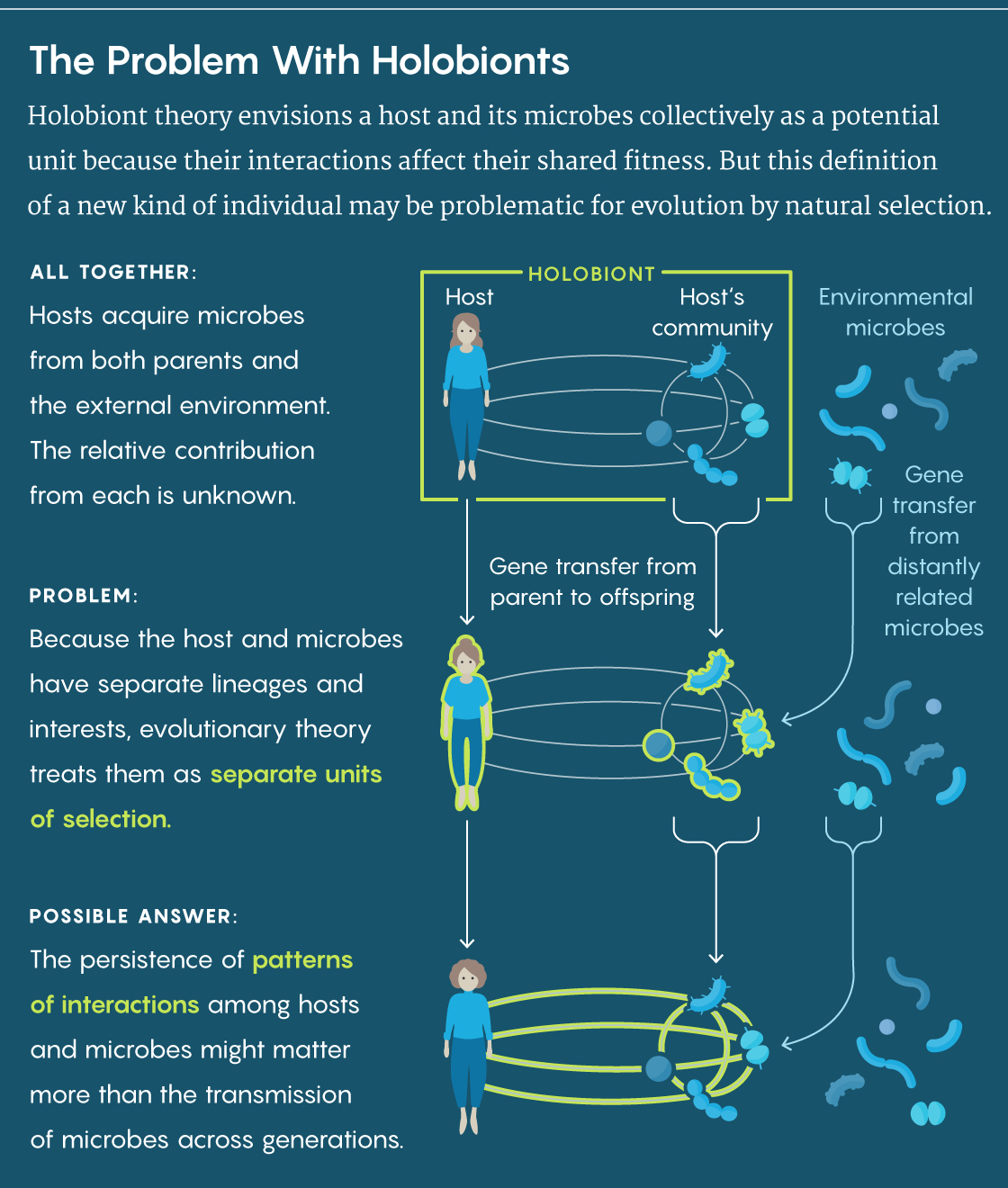
Lucy Reading-Ikkanda/Quanta Magazine
Do holobionts meet those criteria for evolving entities? Microbes and host genomes can interact in ways that profoundly affect host fitness. But whether we inherit our microbiome in something like the way we inherit our genome remains a point of contention.
Parents do pass along microbes to their offspring. For example, females of some species of stink bug nestle a fecal pellet near freshly laid eggs to serve as the larvae’s first meal, thereby inoculating them with their mother’s gut microbiome. Typically, human babies not born by cesarean section acquire their mother’s vaginal microbes en route to the outside world. Mom’s microbes also rub off on a baby through close contact and breastfeeding. Although eventually the microbial community changes as the child moves more freely through the world, these early microbes play an outsize role in immune system development.
Not all of the microbiome is transferred from parent to offspring, but according to Bordenstein, it doesn’t have to be. “Nobody I know expects the microbiome to be inherited in its entirety, faithfully,” said Bordenstein. But if a significant portion of it is, he and others argue that those interactions and their evolution might be understood as a unit of selection.
Poking Holes in Hologenomes
Other researchers think the hologenome concept of evolution stretches the notion of a selectable unit to the point of incoherence. “Just because the microbes are there with one organism at one time does not mean they are a unit of selection, especially if they are not passed on vertically,” said Joan Strassmann, an evolutionary biologist at Washington University in St. Louis who studies microbes.
“I don’t want to make the strong claim that vertical transmission is absolutely necessary, but it’s certainly the most likely mechanism to lead to the cumulative evolution of the partnership as a whole,” said Derek Skillings, a philosopher of biology at the University of Pennsylvania and the City College of New York.
Skillings and other critics argue that there just isn’t enough evidence of vertical transmission of symbionts to allow for the holobiont to be a coherent evolutionary individual. Many of a host’s microbes are acquired from the outside environment, not from its parents. Even when the environment is shared, there is little reason to assume that a parent’s microbes will make it to its offspring. Even if they’re the same sorts of microbes, the direct line of vertical transmission is still necessary to form an evolutionary individual.
Skillings further argues that the repeated co-occurrence of species in nature does not imply that they have shared interests. Consider a host and a parasite locked in perpetual conflict: Every generation, they come together and attempt to subvert each other. You could even imagine a familial line of hosts being infected by the same familial line of parasites. Nevertheless, persistent as this relationship is, Skillings argues that you’re only going to understand it by considering each lineage’s interests separately. Proponents of the hologenome concept acknowledge that cooperation, conflict and even neutrality can influence the evolution of the holobiont, making the disagreement less about the facts of the matter, and more about how to approach them.
Strassmann argues that focusing solely on what’s happening in the holobiont misses much of the microbes’ story. Many host-associated microbes spend significant chunks of their lives outside their host, in an environment where they’re subject to very different selection pressures. The holobiont idea, she says, puts blinders on our understanding of the evolution of these microbes, focusing attention on the host environment and neglecting other habitats that could shape a microbe’s character.
Critics of holobiont-centered theories are not discounting the importance of studying the interconnections between microbes and hosts, but they think the holobiont framework is almost always misleading. They envision the holobiont as an ecological community, not an evolutionary individual. The knowledge that symbiotic relationships with microbes are important “doesn’t mean we have to completely forget what we know about how evolution and natural selection operate,” Strassmann said.
But translating existing ecological and evolutionary theory to this new microbial world is more easily said than done, cautions Britt Koskella, a biologist at the University of California, Berkeley. Many of these theories were built to explain how plants and animals interact and coexist, and “there are well-understood aspects of microbial ecology that just don’t fit here,” she said.
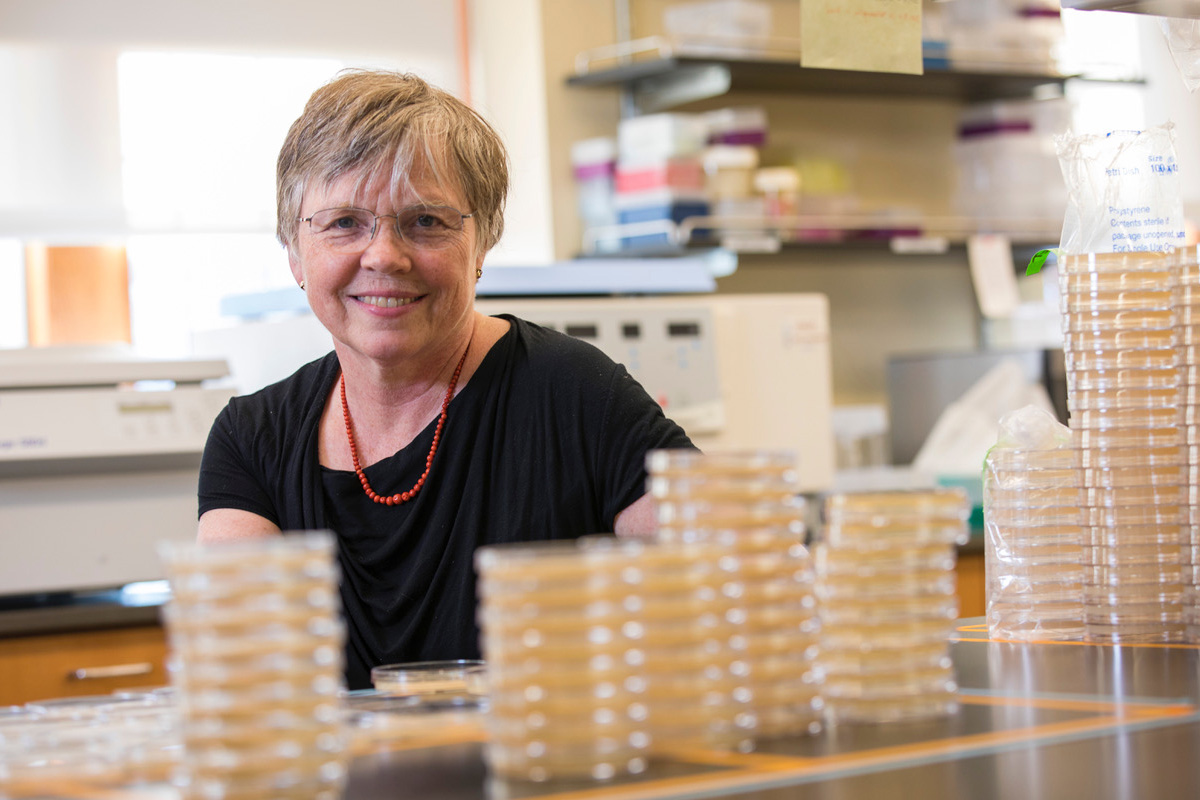
Joan Strassmann, an evolutionary biologist at Washington University in St. Louis, thinks that a hologenome concept of evolution pushes the idea of selectable units too far.
Joe Angeles/Washington University
Take ecological succession, a framework for evaluating how a community assembles over time. The state of a plant community on a new island, for example, may depend much more on the order in which species arrived and the niches they filled than on the local evolution of the plants, because evolution is usually so much slower.
But bacteria evolve much faster than plants and animals, and they can swap genes instantaneously via horizontal gene transfer. “Now you have to consider the possibility that a microbe could arrive and, whether by mutation or horizontal transfer, fill all available niches before anyone else shows up,” Koskella said. Bacterial succession might work in different, counterintuitive ways from traditional succession.
Other differences to consider, according to Koskella, include the influence of a host’s immune system over its microbiome and microbes’ ability to dynamically alter their environment. She argues that theoreticians need to think through basic assumptions made by their models and consider whether they apply equally well to microbes, and empiricists need to test the predictions of those models. “Cross-talk between empiricists and theoreticians is really important,” Koskella said. “The data are just so complex, and we’re very quickly moving beyond intuition.”
Settling empirical questions, such as how often a substantial portion of the holobiont is inherited, and how stable communities are across generations, will help sharpen intuition and inform theoretical work. “We can keep just asking questions and getting data, but without theory, you don’t really know how to begin interpreting or testing all this complexity,” Koskella said.
It’s the Song, Not the Singer
One radical idea seeks to forge a third way forward by turning the problem on its head. Forget about the particulars of which microbes are doing the interacting or whether they’re vertically or horizontally transmitted, its proponents say — just focus on the interactions, the stable metabolic processes enacted by various microbial players.
“It’s the song, not the singer,” said W. Ford Doolittle, an evolutionary biologist at Dalhousie University in Nova Scotia. He and his former Dalhousie colleague Austin Booth originated this idea and gave it its name, abbreviated ITSNTS, by inverting the title of a Rolling Stones song. They argue that it captures what’s so compelling about the idea of holobionts, namely the stable networks of interaction patterns among disparate lineages, without ascribing a special evolutionary identity to them. Instead, the processes themselves form a sort of evolutionary lineage.
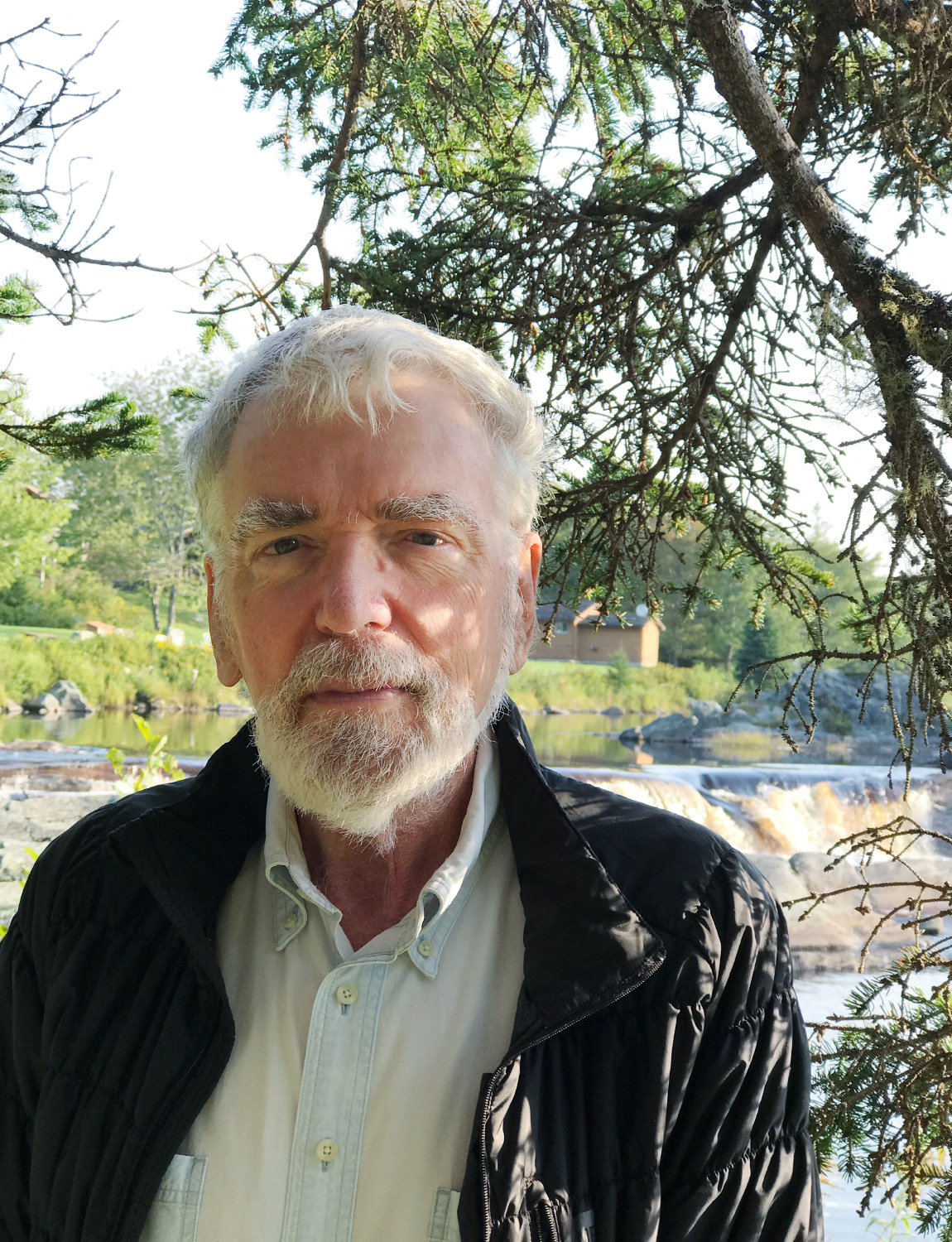
W. Ford Doolittle, an evolutionary biologist at Dalhousie University in Nova Scotia, is one of the authors of a new evolutionary concept in which stable patterns of metabolic interactions among hosts and microbes — but not necessarily the organisms themselves — might serve as a unit of selection.
Courtesy of Ford Doolittle
Doolittle and Booth begin from the observation that gut microbiomes contain a wide diversity of species and strains across many bacterial taxonomic groups but exhibit a remarkable conservation of core functions performed by those organisms. These networks of different players participate in metabolic cycles, in which a set of bacteria converts nutrients to metabolites, which get picked up by other bacteria to produce a different metabolite, which gets used by the host, and the cycle continues. Many of these functional steps can be carried out by myriad strains present in the gut, making any given strain potentially redundant. But the cycle itself continues, regardless of which cells are enacting it.
Doolittle illustrates the idea using the nitrogen cycle. Atmospheric nitrogen gets churned through a series of chemical states by a diverse assortment of bacteria, plants and decomposers like fungi performing different reactions. Each step in the cycle can be carried out by innumerable species that all belong to a kind of “functional guild,” but the process itself remains remarkably stable.
Once these networks exist, they create a niche for other microbes to occupy. The cycle becomes a sort of structure for various lineages to grab onto, a way for them to make a living. “If you make the leap and think of these interaction networks … as populations of entities, you can begin to understand them as units of selection,” Booth said. “It turns traditional ways of thinking about evolution on its head. The materialistic basis of lineages takes a back seat.”
Doolittle and Booth liken this to the way songs perpetuate themselves as cultural entities. “There are songs which have lasted for a long time basically because a lot of people were happy to sing them,” Doolittle said. Individual singers come and go, but even in cultures where written and recorded music don’t exist, the songs survive by recruiting appropriate talent in new generations. Similarly, once a metabolic network exists, diverse lineages of organisms can evolve to perform some of the interactions and processes that define it — and evolution can support that association because it is selfishly advantageous for the individuals, or genes, within the various lineages to do so.
Processes being selected via differential persistence is certainly an unusual idea, but not unprecedented. Cultural evolution of ideas in the form of “memes,” while controversial, is seen by many as at least plausible (the meme concept was itself inspired by the biological concept of genes). In this case, the idea or meme is the metabolic interaction, and it persists based on its ability to recruit microbes to carry it out.
It remains to be seen how useful this framework might be for studying the holobiont, and significant kinks remain to be ironed out. The notion that differential persistence is analogous to differential reproduction might seem strange to many evolutionary biologists, and it’s still far from clear how to define a metabolic network.
Fertile Ground
Spirited argument over how evolution fundamentally works is nothing new. “Evolution, if you look at the history of the idea, has always been beset with these kinds of debates,” Booth said, referring to early debates about whether evolution proceeded gradually or in fits and starts.
“It’s safe to say that the microbial revolution has been impactful in that it throws so many of the traditional ideas out, or at least casts them in a new light,” Booth said.
“I think we’re just beginning a field here,” Bordenstein said. He points to the early days of genetics. “Those early questions were so basic — what is a gene? How are genes inherited?” Biologists are just starting to get a handle on the basic questions of microbe-host interactions. “Who’s there? What is the complexity of the holobiont and how do its parts function together? We have a century’s worth of work ahead of us to figure this out.”
Strassmann agrees. “It’s really important that we keep talking to each other. We have so much exploring to do.”
This article was updated on Nov. 20 with additional links to some of the relevant scientific papers.


